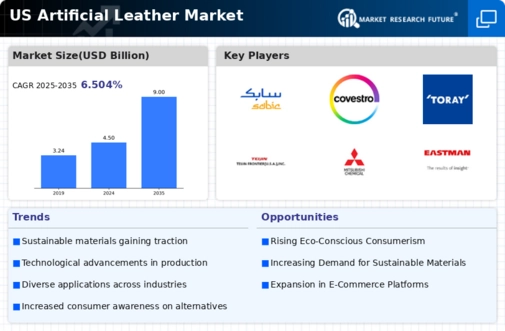The US Artificial Leather Market has witnessed significant transformation and competitive dynamics over the years, influenced by sustainability trends, consumer preferences, and technological advancements. Companies in this market are constantly innovating to develop synthetic leather alternatives that mimic the texture and aesthetics of genuine leather while being environmentally friendly and cost-effective. This market is characterized by a mix of established corporations and newer entrants who are gradually making their mark by focusing on eco-conscious production methods and novel applications across various industries such as fashion, automotive, and home furnishings.
The competition is becoming increasingly fierce as companies strive to gain market share through strategic partnerships, product differentiation, and expanding their geographic reach, ensuring a vibrant landscape ripe for growth and development. SABIC has positioned itself as a strong player in the US Artificial Leather Market, leveraging its extensive research and development capabilities to produce high-quality thermoplastic materials suitable for various artificial leather applications. The company's technology focuses on providing unique solutions that cater to the needs of diverse customer segments, including apparel and automotive manufacturers.
SABIC's strength lies in its commitment to sustainability, offering products that meet environmental regulations and consumer demands for greener alternatives. Additionally, the firm benefits from its global presence and established supply chain, which enables it to scale operations efficiently and maintain competitiveness within the ever-evolving market landscape. By emphasizing innovation and sustainability, SABIC continues to reinforce its position in the artificial leather sector. Lear Corporation stands out in the US Artificial Leather Market by specializing in automaker solutions that include premium seating systems, interior components, and electronic systems.
The company's focus on advanced material science allows it to produce high-quality artificial leather that meets the stringent standards required by the automotive industry. Lear Corporation's strengths include its strong research and development pipeline, fostering consistent innovation that aligns with industry trends and consumer preferences. The company has established itself as a trusted supplier through strong relationships with major automotive manufacturers, which enhances its market presence. Additionally, Lear Corporation has participated in strategic mergers and acquisitions to broaden its product portfolio and geographic reach, thereby reinforcing its competitive position in the artificial leather market within the United States.
With its commitment to excellence and a forward-looking approach, Lear Corporation continues to navigate the complexities of the market successfully.




















Leave a Comment